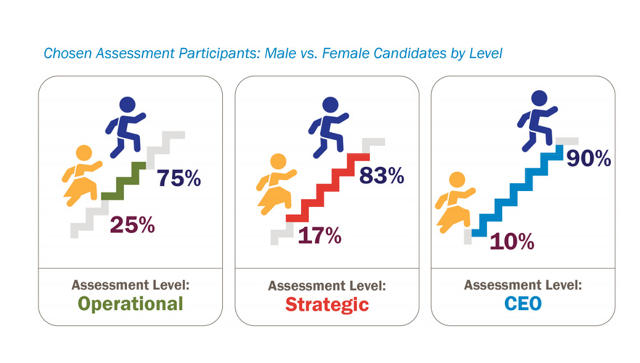Why isn’t Equality In leadership skills altering The collection of feminine Leaders?
each men and women rating in a similar fashion of their means to power business, but fewer ladies are rising beyond decrease administration.
February 1, 2016
right here’s a special approach on the gender divide in management: men and women rating nearly equally in their means to force businesses, however fewer women are able to get beyond decrease-degree leadership positions.
The discovering involves us from a new find out about conducted with the aid of DDI. The file is a synthesis of assessments taken with the aid of 15,000 contributors being thought to be for leadership from the entrance traces to executive levels at 300 firms in 18 international locations. DDI evaluated the information from character and intelligence checks as well as from “day-in-the-lifestyles” simulations that allowed members to reveal their talents.
DDI’s report (like others) suggests that gender equality in leadership nonetheless has a long way to go, despite the equity in ratings. Their findings show that the ratio of men to girls chosen to complete these assessments was once weighted in favor of male individuals. in line with the file’s authors, as a result of these assessments symbolize funding, they’re a reliable indicator of gender diversity among excessive-attainable leaders.
“some distance extra girls are chosen as candidates for evaluation at lower chief levels than at senior ranges,” the authors write. “This conveys to girls: It’s okay to be a decrease-degree chief, but you’re no longer but able to upward thrust to the top.” but possibly now not even that. on the operational degree, the gender break up is seventy five% men to 25% girls.

This performs into findings from the latest McKinsey/LeanIn.org learn about, which revealed that across the advancement board, from entry degree to supervisor and from SVP to executive rank, ladies are less likely to improve, with the greatest disparity occurring between supervisor to director. girls are best seventy nine% as prone to reach that degree, compared to 100% of fellows.
The McKinsey/LeanIn.org find out about factors to two traits standing in the best way of girls rising through the ranks. even though the likelihood of development is equal at entry degree, it drops off as fewer girls take on roles that lead to executive management positions. extra women are present in departments comparable to HR, prison, and IT, the place job duties don’t immediately influence the bottom line.
however a Deloitte find out about revealed that even amongst lower-ranking millennials, the disparity was evident. Twenty-one % of millennial men mentioned they lead a department or are members of their organization’s senior administration staff vs. sixteen% of ladies.
DDI’s analysis provides to these findings indicating that the rationale there aren’t more girls in high-stage management is just not rooted in lower competence. in reality, analyzing the diversities between men and women on industry drivers showed that there were no statistically significant variations, and neither gender got extraordinarily high scores.
What are business drivers? Evan Sinar, PhD, DDI’s chief scientist, tells quick company that they’re a targeted set of huge management challenges that leaders absolutely should overcome to execute the organization’s business technique. “they provide the crucial trade context in opposition to which chief readiness is evaluated.” He adds, “they’re measured through mapping both abilities and personality components (including both enablers and derailing elements of personality) to every driver.”
He additionally notes that a number of of them “pressure necessary conversations about prioritization of management boom goals.”
members had been scored on a four-point scale ranging from no longer ready (lowest), to construction wanted, to ready to potential (very best). “since the average rating is less than three, we know that on average, leaders fall between the development needed and prepared factors,” Sinar says. better rankings imply a better percentage of leaders that are ready.
in line with the document’s authors:
We’ve additionally heard substantial discussion about men being higher at the “more difficult” side of business, while women shine within the “softer” aspect. however in having a look at the “softer” versus “tougher” industry drivers, there’s little strengthen for this proposition.
important distinctions did come up on three personality traits:
Inquisitiveness. men scored 16% larger, which DDI attributes to several conceivable causes, together with the fact that there are extra men in STEM careers that both make stronger and reward structured inquiry. “also striking are cultural attitudes and practices,” the file’s authors write. “In some international locations, girls coming into the team of workers have been raised in an surroundings that strengthened silence over curiosity.”
Impulsiveness. men scored 11% larger than women on this trait. “We surmise that men are strengthened to ‘simply do it’ with out considering penalties,” the record’s authors write. girls tend to behave extra cautiously, particularly when taking into consideration a merchandising, in keeping with latest research from Harvard business school. DDI’s researchers posit that ladies are also inspired not to proceed unless they are certain they can do one thing perfectly.
Interpersonal sensitivity. that is the character trait by which women got thirteen% larger marks, and it is an asset, particularly when leaders are in positions that depend on their demeanor and interactions with others.
The learn about authors inspire businesses to believe emphasizing all varieties of range by using selling give a boost to groups, versatile schedules, sponsoring networking alternatives, and mentoring.
DDI’s researchers found that almost two-thirds of women have never had a formal mentor. “Even one excellent mentor manner they’re more more likely to climb the organizational ladder,” they say.
fast company , learn Full Story
(79)














